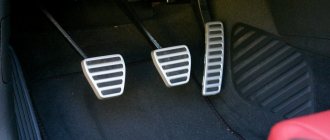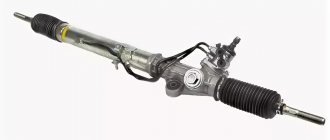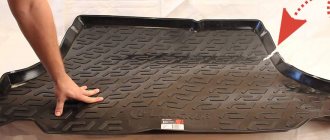If you see any liquid coming out of your exhaust pipe, you should first determine what it is and whether it is dangerous before you panic. This can be either water or a mixture of gasoline.
There can be several different reasons why water or gasoline may be coming out of your exhaust pipe, and some of them are not a problem at all, while others can be very serious problems. Follow the steps below to understand how serious your problem is.
Why does the exhaust pipe smell of gasoline and how to solve this problem?
After discovering the cause of the malfunction, the car must be placed in an inspection hole and very carefully trace the path of the fuel from the fuel tank to the carburetor, and if the engine is fuel-injected, then to the injectors.
It will be necessary to tighten all the fittings and clamps on the connecting hoses of the fuel line. Often on domestic cars, after just 3-5 years of operation, the gas tank turns into a sieve.
If during inspection no gasoline leaks were detected, then you should try to study this problem in as much detail as possible.
Possible engine problems
Does the muffler smell like gasoline and is it not very comfortable to drive? Then, the first thing to do is to unscrew the spark plugs and try to understand in which of the cylinders the fuel does not burn and passes further through the exhaust manifold. The location of the gasoline leak will be indicated by a wet or greasy spark plug.
It is not uncommon for the chamfer of one of the exhaust valves in the combustion chamber to burn out. It is from there that the fuel-air mixture exits into the exhaust pipe. An experienced auto mechanic can help eliminate the penetration of the gasoline mixture.
It will be necessary to change the rings on the pistons, valves, and sometimes the pistons themselves. So, we can assume that the car owner is provided with an average repair of the power unit. However, there is no need to rush into repairs; first, it is better to diagnose the engine, because not everything is always so hopeless.
A poorly fitting spark plug cap or high voltage wire can cause the spark plug to operate intermittently. This may allow fuel to flow freely into the exhaust manifold. There is no need to be alarmed if some kind of liquid suddenly pours out of the muffler, because it is not fuel, but condensation formed on the walls of the muffler when starting the engine. Of course, it may smell like gasoline, but don’t worry, it’s not gasoline.
When should you be wary?
In some cases, the release of water indicates certain problems with the motor:
If strong condensation comes from the exhaust, which does not stop when the engine warms up and is accompanied by white smoke, there is a breakdown of the cylinder head gasket (cylinder head). This means that the crack has connected the channels of the block's water jacket with the combustion chamber. Antifreeze penetrates the cylinders, evaporates from the high temperature and is thrown into the exhaust system. As a result, you observe the release of white steam and coolant, which has managed to partially condense.
Advice. If you discover a violation of the integrity of the cylinder head gasket, immediately begin repairing the power unit. Driving with this malfunction is unacceptable.
Both the color of the exhaust gases and the color of the condensate may indicate a specific problem. Black water from the muffler indicates a large amount of soot contained in the smoke and deposited on the inner walls of the pipes. There are two reasons for its formation:
There are cases when soot from unburned or low-quality fuel completely clogged the pipeline system, making it impossible to start the engine.
An oily puddle under the exhaust pipe may indicate wear on the cylinder-piston group or valve seals. Engine lubricant, penetrating into the cylinders, burns and is partially released into the flue and mixed with condensate. The problem is accompanied by bluish smoke, carbon deposits on the electrodes of the spark plugs and increased oil consumption in the engine.
Sometimes condensation turns an unusual yellow-green color. This color indicates a high sulfur content in the fuel, which is a sign of low quality.
Problems of a modern engine
If you drive a modern fuel-injected car, and the Glushak “rushes” like an old Volzhana, we can conclude that the fuel is being over-enriched. The cause may be improper operation of the lambda probe. On fuel-injected cars there is a valve that regulates the discharge of unburned fuel back into the gas tank. If it breaks down, the gasoline will be very rich. A failed air mixture sensor can create a similar problem. An auto electrician will be able to “deal” with such a malfunction very quickly.
Common motor problems
Does the exhaust pipe smell of gasoline and do you feel uncomfortable driving your car? The first step is to unscrew the spark plugs and determine in which specific cylinder the fuel is not burning and is rushing further along the exhaust manifold. A spark plug that is wet or has a greasy appearance than others will show you the main location of the gasoline leak.
If all the candles are evenly greased
, then open the oil filler neck and look at the condition of the oil and the presence of light brown foam on the neck cap. This foam indicates that it is time to change the piston rings because in the absence of compression in the engine cylinders, the entire combustible mixture does not burn and fuel particles are carried away into the exhaust pipe.
Cases are not uncommon
, when the chamfer of one exhaust valve in the combustion chamber gradually burns out and through it the gasoline-air mixture constantly breaks through into the exhaust pipe. An experienced mechanic will help eliminate gasoline leakage in it.
It is necessary to replace the piston rings, valves, and in advanced cases, the aluminum pistons themselves. That is, you are guaranteed an average engine repair. And yet, you should not rush into repairs; first, diagnose the engine.
Not everything is so bad
. A loose cap on the spark plug or a high-voltage spark plug wire with a breakdown will cause the spark plug to work intermittently, which will allow gasoline to flow freely into the exhaust manifold.
But don’t be alarmed if you see some kind of liquid pouring out of the muffler in a stream or drop by drop; this is not gasoline, but steam condensation that forms on the cold walls of the muffler when the engine starts. Although condensation can also smell like gasoline.
Why is fluid leaking from the exhaust pipe?
If you see any liquid coming out of your exhaust pipe, you should first determine what it is and whether it is dangerous before you panic. This can be either water or a mixture of gasoline.
There can be several different reasons why water or gasoline may be coming out of your exhaust pipe, and some of them are not a problem at all, while others can be very serious problems. Follow the steps below to understand how serious your problem is.
How does moisture get inside the muffler?
We regularly encounter the phenomenon of condensation in everyday life, and it is always undesirable, no matter where it occurs, and sometimes it can act destructively on structures, being also one of the provoking factors for corrosion. Every schoolchild knows from physics lessons where condensation comes from, and if water begins to flow out of the muffler, which can most often be detected when starting a cold engine, then this is not a sign of design defects. Let's take a closer look at why water drips from the muffler, which promotes condensation. The reasons for the formation of condensation in the exhaust system of a car lie in physical processes, as well as chemical reactions occurring in the internal combustion engine chamber:
Thus, the reasons why water leaks from the muffler can be external and internal. It is impossible to eliminate the formation of condensation that occurs naturally, although there are ways to reduce the extent of its manifestation by creating special conditions.
If you have water coming out of the exhaust
In most cases, if there is water coming out of your exhaust pipe, it should be accompanied by white smoke. This is a good thing as it can help you more easily identify your problem and fix it accordingly. Fortunately, in most cases, when water comes out of the exhaust pipes, it is not a problem, since only condensed water will form in the exhaust system (this usually happens on colder days).
You can confirm this if white smoke comes out of the exhaust pipe, it should be very thin and vapor-like. This problem can be easily resolved if you let the machine run for a few minutes (the smoke should become colorless) and if this happens, you have nothing to worry about.
On the other hand, if the car has been running for several minutes and the white smoke coming out of the exhaust pipe is very thick, it could become a more serious problem for your engine.
THE SMELL OF PETROL WHEN STARTING THE ENGINE
The situation looks slightly different when starting the engine, especially in winter. At the same time, quite often the smell of gasoline is felt, sometimes so strong that one gets the impression of fuel flowing in a stream. However, if it disappears after the engine warms up, there is nothing to worry about.
When starting a cold engine, the ignition controller in the car makes the mixture over-rich. As a result, some of the fuel does not burn and is thrown out of the exhaust pipe into the street, which is why the smell of gasoline will be felt.
This can happen even due to one inoperative engine cylinder, but if this is a permanent defect, then it will be accompanied by other manifestations, such as loss of power or deterioration in driving dynamics.
If such a phenomenon exists only during startup and disappears when the engine warms up, then it is associated only with a cold start; when the temperature rises, normal operation of the engine should be restored.
If gasoline is coming out of your exhaust
If there is gasoline coming out of the exhaust pipe, you will probably notice black smoke coming out. If this is indeed the case, then this is a sign that an incomplete burn has occurred in the combustion chamber. This is caused by excess fuel in the air/fuel mixture and can be caused by several different parts failing.
In most cases, this is not a very serious problem and is caused by a dirty air filter that has not been changed in a long time and it cannot supply the necessary air to the mixture.
Replacing the air filter is a very simple operation and you can do it in less than one minute. If this doesn't solve your problem and there's still gasoline/black smoke coming out of the exhaust, you're probably looking at more serious engine problems.
The most likely parts causing these problems are a leaking fuel injector, a closed fuel regulator, or a restricted fuel return line. If you have any of these problems, they are serious enough that you need professional help to fix them. You should do this as soon as possible to prevent the problem from getting worse than this.
What are the dangers of having water in the muffler in winter?
Despite the fact that the presence of condensate in the muffler does not pose a particular threat, it would be wrong to turn a blind eye to it. The first and main reason for this is the appearance of corrosion due to constant contact of metal with liquid.
If exposed to moisture, the exhaust pipe may become corroded.
Please note that in winter the process of corrosion formation occurs several times slower than in summer. So there is no need to panic: you have enough time to solve this problem.
Another unpleasant point: if the condensate is not defrosted and drained, its level can increase significantly. This will lead to the formation of an impassable ice plug. After just a few days, you will not be able to start your car. To avoid this, it is enough to warm up the car at least a little every day. Also, do not leave the car to warm up at idle speed, as the exhaust system will remain cold, which will allow water vapor to settle.
If you do not warm up the car completely, an impassable ice jam may form.
A popular solution to the problem is to make a small hole in the resonator. In this case, the liquid will flow freely and not accumulate on the walls of the exhaust pipe. However, the hole can cause rust to form even faster. This means that this part will have to be replaced several years ahead of schedule. In addition, the main cause of muffler corrosion is not condensation, but the aggressive effects of exhaust gases. Moisture can only speed up this process. However, if you still decide on such a procedure, watch the video, which explains where and how exactly to make the hole.
Soot from the exhaust pipe: what is the reason?
The color and intensity of engine exhaust for an experienced car enthusiast is like the patient’s body temperature for a doctor. An experienced eye only needs to watch, listen and smell for a couple of minutes, and a diagnosis can be made. In most cases, the normal color of the exhaust from the muffler does not attract attention, and if suddenly on the road cars overtaking you honk and point at the muffler, it is worth stopping and assessing the problem.
A car with a black exhaust from the muffler is, to put it mildly, not welcome on the road. It’s good if you have the patience to ignore the signals of motorists, but it’s unlikely that you’ll be able to drive past the striped rod with impunity.
Is it possible to reduce the amount of liquid in the exhaust?
The intensity of condensation inside the exhaust system is practically independent of the make and model of the car. It should be understood that a small amount of water in the pipe is normal. The exception is a situation when liquid flows like a river due to a cylinder head gasket failure.
Since you can't control the chemical reaction of gasoline burning to release water vapor, try to combat condensation. What is needed for this:
There is only one way to meet these requirements - store the car in a warm, tightly closed garage equipped with exhaust ventilation. Less moisture will fall out of the heated and drier air, and thanks to the positive temperature, the condensate will evaporate during parking and be removed through the hood. Please note that it will not be possible to completely get rid of water droplets from the muffler.
Condensation in a car exhaust system occurs when cold and hot air mix. Dripping water from the muffler always frightens a novice car owner. Is it so scary and what negative consequences could there be?
Gasoline from the exhaust pipe.
| Registered: Fri Oct 03, 2008 1:49 pm | Motorcycle CB400 SF VTEC3 2004 Apparently there is a problem with the carburetors. What do you advise? What to do, where to look, what to turn? I live on Timiryazevskaya, is there anyone nearby who could assess the scale of the problem? | ||||||||
|
Gasoline from the exhaust pipe.
Registered:Fri Oct 03, 2008 1:49 pm
Messages:
29
From:
NEAD, Yablochkova
Apparently there is a problem with the carburetors.
What do you advise? What to do, where to look, what to turn?
I live on Timiryazevskaya, is there anyone nearby who could assess the scale of the problem?
| Registered: Wed May 07, 2008 9:46 pm | |
| Registered: Fri Oct 03, 2008 1:49 pm | I don't have a tap under the tank. There's a membrane there, as far as I understand. There were no starter jams when starting the engine. everything was as always, it started right away, but not completely. But how to get into the carburetors is a problem for me. I can't even imagine how to remove them. and there is a fear that if I take them apart, I will hardly be able to put them back together. Today I got a version, but could it be the candles dying? Those. 2 or 3 spark plugs are working, the engine has started, the combustible mixture enters the cylinders, but the mixture that does not burn is spat out into the muffler. Could this be? |
| Registered: Tue Apr 01, 2008 5:30 pm | Then it would have smelled of gasoline from the exhaust, and not flowed like a stream. |
| Registered: Fri Oct 03, 2008 1:49 pm | |
| Registered: Sat Jan 26, 2008 9:56 pm | |
| Registered: Fri Oct 03, 2008 1:49 pm | That's how things are. I don’t know if I’ll start in the morning. Time zone: UTC + 4 hours |
Causes of condensation
To understand the causes of condensation formation, you should repeat your school physics course. It is known that gasoline is a flammable mixture of light hydrocarbons. Hydrocarbons, in turn, when burned, form ordinary water and other gaseous substances. This will happen even if high quality gasoline is used.
Now we need to understand how this moisture ends up in the muffler. Everything is simple here: there is such a thing as the dew point. This is the air temperature at which water vapor will begin to settle. The exhaust pipe is an external element of the car, which means it cools quite quickly. The cold metal surface combined with the warm air inside creates an ideal environment for condensation to form.
The cold surface of the muffler promotes the formation of condensation
If the car is equipped with an autostart system, the presence of condensation will be much more noticeable. The thing is that the pipe warms up much faster. In this case, the condensate has time to thaw, but does not have time to evaporate. If you start driving at this moment, the cars driving behind you will see water splashing out of the muffler.
Short trips at low city speeds, such as from home to work, are also an aggravating factor. Try to get out on country roads at least once a week: the speed limit on them will be sufficient to prevent the formation of ice jams. And it is absolutely not necessary to break traffic rules.
What to do if the condensation has an unusual color
It happens that the puddle under the exhaust pipe has an unusual shade: black, blue or even yellow-green. There may be several reasons for this:
- some parts of the car are leaking, and coolant or oil is leaking, which tints the condensate;
- low-quality gasoline with a large number of additives that do not burn and fly out along with condensate;
- soot settles in the exhaust pipe, which mixes with water and gives it a black or dark gray color;
- The yellow-green tint of the condensate is a consequence of the increased sulfur content in the fuel.
In some cases, the condensation may appear an unusual color, such as blue
To determine what the problem is for you personally, you should carry out simple diagnostics yourself.
- To determine if there is oil in the condensate, warm up the engine well, and then cover the exhaust pipe opening with thick white paper. Set the sheet aside and let it dry. If the condensation consisted solely of water, the paper would dry completely. But if there are oil impurities, greasy marks will remain on it.
- Look under the hood and make sure there is no oil film anywhere. If there is a leak somewhere, you will notice a characteristic smell.
- Check the oil and antifreeze levels. Excessive flow may indicate a leak.
- Study the spark plugs. If one or more look completely clean, it means that coolant has come into contact with it.
- Overheating of the engine can lead to burnout of the cylinder head cover gasket and oil leakage.
- If visual diagnostics do not show any problems, try changing gas stations. Perhaps the problem lies in low-quality fuel.











